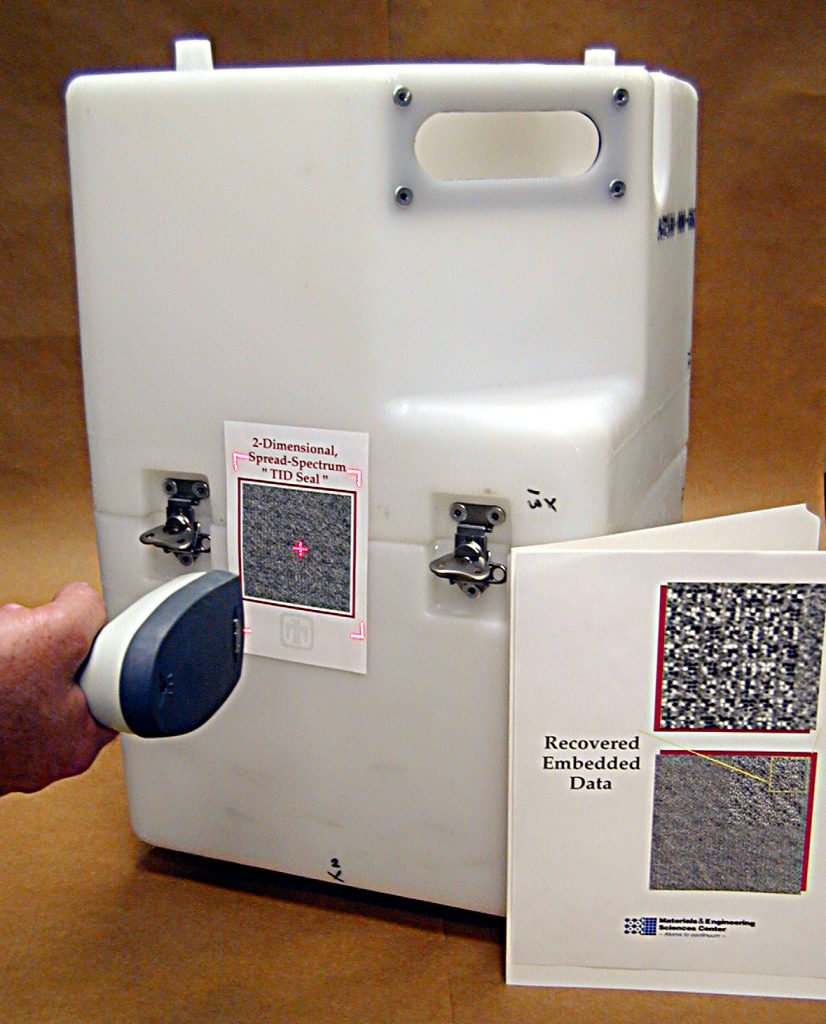
LIVERMORE, Calif. — When a Sandia National Laboratories team tackled a new way to make barcodes secure, reliable and inexpensive, their thoughts turned to shades of gray.
They created a mottled “spread-spectrum” barcode that is just as easy to scan as the lines of a Uniform Price Code, with additional advantages.
“Manufacturing, inventory, shipping and control of precious or perishable materials could all benefit from this application,” said Scott Vaupen of Sandia’s Business Development Support Department in Livermore, Calif.
The code is readable even if 70 percent is missing or obscured; it contains embedded correction parameters it can encrypt and limit access to various levels of information; and it can be re-set during inventory, as well as potentially be used to track elapsed time, temperature, or environmental conditions.
In fact, the code, which resembles the marbled cover of a composition notebook, doesn’t actually have to be seen as a distinct barcode. It can be hidden in a logo, designed to expire after a period of time, or indicate suspicion of tampering when used as a seal.
“There are a large variety of alternatives that we would like people to get out there and run with,” said Bill Even, the Sandia/California manager who began this patent-pending research three years ago.
Unlike the UPC’s sequence of bars and spaces that is read as dark and light intervals, this 2-dimensional pattern repeats like a speckled wallpaper print.
Sandia/California researcher Eric Cummings compares the approach to the way phone lines carry modulated transmissions across a spectrum for greater fidelity.
“Each bit of data is encoded pseudo-randomly across the entire barcode,” Cummings said. “All of the encoded bits are then overlaid to form a grayscale, or analog, barcode image. Because each bit of data is spread redundantly across the barcode, you can recover all of the data even when some or most of the barcode is missing — providing you know the key to the pseudo-random code.”
Even if ripped or written over, the pattern still reveals its embedded information when scanned by a regular CCD camera. On the other hand, the average person can’t decode the encrypted data, or counterfeit a copy. Higher-end versions that are not just run off a desktop printer can include self-assembled, luminescent particle “fingerprints”, temperature-sensitive gels or inks that can be reset by changing temperature, chemically sensitive inks to indicate spoilage, among other possibilities.
“There is sort of this big void,” Even said, between tags that might cost less than a dime and highly secure sealing schemes that require thousands of dollars investment. His project targeted that gap with an affordable alternative that can be scaled to either provide economically robust information in a tag and/or confer security as a seal. Applications, then, could range from basic retailing, warehousing, manufacturing, and industrial or mine safety to secure mail routing, private labeling and ID badges. At the most secure end, with a “re-writable” surface gel for authentication, federal agencies might appreciate the ability to automatically measure damage or tampering to protect currency or goods such as pharmaceuticals, precious resources, or nuclear material.
The distributed-fiducial, scan-correlation concept allows applications in aerospace, non-destructive evaluation and optical targeting by enabling global, rapid distortion detection and precision alignment and calibration.
For information regarding possible collaboration towards commercialization or licensing opportunities, contact Scott Vaupen at (925) 294-2322, sbvaupe@sandia.gov.
Technical contact:
Scott Vaupen, sbvaupe@sandia.gov , (925) 294-2322